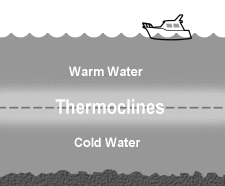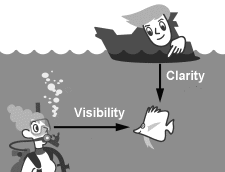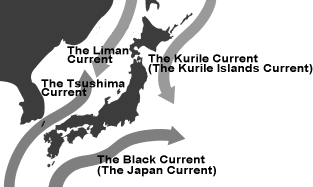 Ocean Conditions 2 Ocean Conditions 2
|
|
■Thermoclines
Where warm and cold ocean water or where fresh water and salt water meet underwater, the scene seems to dim and flicker and vibrate – this is a thermocline.
|
 |
|
|
■Water Clarity and Visibility
Underwater, plankton and other floating matter as well as silt stirred up from the ocean’s bottom can worsen water clarity and visibility. When these are bad, both seeing around you and at a distance are difficult, so it is important not to become separated from your dive buddy. In the opposite case, when clarity and visibility are extremely good, depth perception is slightly off and you can easily overshoot your planned maximum depth, so caution is required here, too. |
 |
|
|
■Ocean Currents
Ocean currents flow like rivers. These currents occur partly due to differences in water’s density. Along Japan’s Pacific Coast flow two main currents - the warm Black Current as well as the cold Kurile Current.
|
 |
|
|
■Tide and Tidal Currents
Due to the gravitational effects of the sun and moon on the earth, twice a day we have high and ebb tides. Tides, causing the ebb and flood of water levels, create tidal currents.
Generally speaking, at new moon and full moon, tidal currents are strongest (spring tides), while neap (low) tides and long tides’ tidal currents are weakest. When ebb and high tides are at their apex, the tidal current stops. The Japan Coast Guard publishes tide tables which you can employ in your dive planning. |
|
|
|

